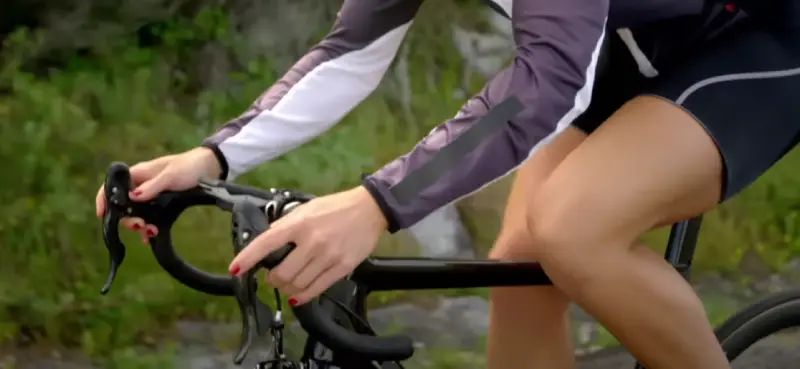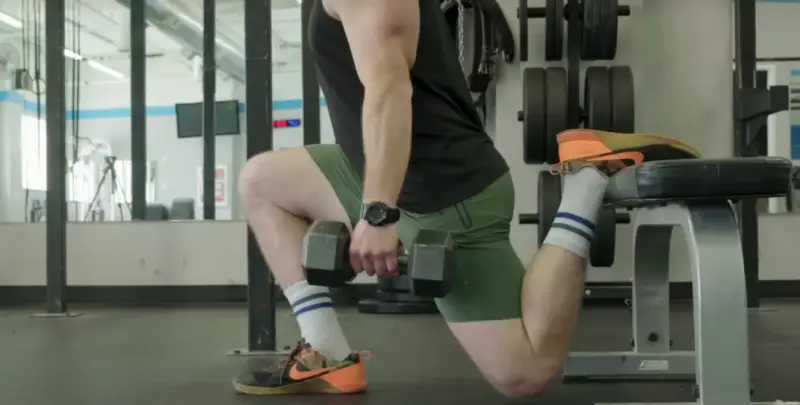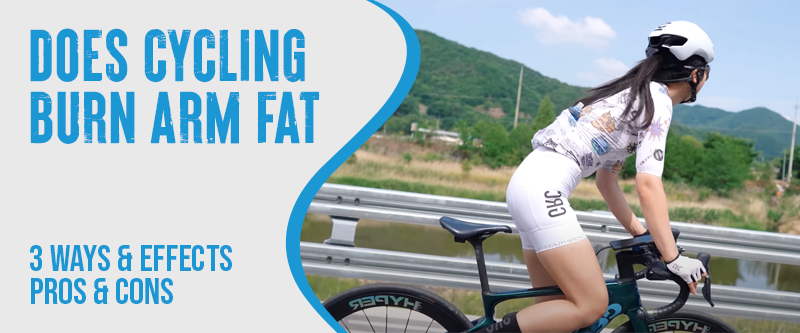Yes, cycling can help you lose arm fat. The best way to cycle for this goal is by using a stationary bike or an elliptical trainer. You’ll need to work up a sweat while pedaling to see results.
Besides the impressive effects cycling has on the lower body, cycling is also beneficial for sculpting and toning the upper body’s muscles. It strengthens the arm’s biceps and triceps muscles. Cycling can help you burn stubborn arm fat to achieve slim and toned arms if you stay consistent.
We’ll explore cycling’s effectiveness as a fat-burning exercise, how it helps reduce arm fat, and the factors that affect its results. We’ll also look at some of cycling’s other benefits and any drawbacks you should be aware of.
Does Cycling Burn Arm Fat? 7 Real Factors Explained

A cyclist is an excellent way to lose body fat, including in the arms, as well as burn calories. We will explore the various ways cycling can help in arm fat reduction.
Effect of Cycling on Overall Weight Loss
One of the primary benefits of cycling as a form of exercise is its impact on overall weight loss. When you cycle, you engage many major muscle groups, including your legs, glutes, and core. This leads to a significant calorie burn, translating to faster weight loss combined with a balanced diet and healthy lifestyle.
Some key facts:
- Cycling can burn between 300 and 1000 calories per hour, depending on weight, speed, and terrain.
- Body fat contains approximately 3500 calories per pound. Cycling a few hours a week can create a significant calorie deficit, leading to fat loss.
- Low-impact exercise such as cycling is easy on joints, which makes it a great workout for everyone.
Role of Cycling in Spot Reduction
While spotting and reducing fat in a specific body area may not be possible, cycling can still help you achieve a leaner, more toned physique overall. By burning calories and shedding body fat, you’ll notice visible changes in your arms, legs, and other areas. Additionally, cycling can help you build muscle tone throughout your body, which can make your arms appear more defined and toned.
Some key facts:
- There is no way to target fat loss in a specific body area through exercises that target that area by doing exercises focusing on that region.
- By engaging in full-body exercises like cycling, you can burn calories and reduce body fat overall, reducing fat in areas like your arms.
- Your arms will appear toned and sculpted if you cycle regularly.
Effectiveness of Cycling Compared to Other Exercises
It’s highly effective compared to workouts that claim to target specific areas of the body. While some activities may lead to more significant strength gains or muscle definition in the arms, cycling is hard to beat regarding overall fitness benefits.
Some key facts:
- Cycling is a gentle, low-impact exercise on your joints, making it an excellent option for people who cannot engage in high-impact activities like running.
- A cycling workout can improve heart health, lung function, and endurance.
- Cycling can also help build strength and muscle tone throughout your body, including your arms and shoulders.
Cycling Burns Arm Fat: Potential Effects
While cycling can contribute to the overall fat-burning process in your body, it may not target specific areas like your arms for fat loss. Cycling is not considered an upper body workout, but you do use your arms in a significant way. A strong upper body is necessary for gripping the handlebars and bending the elbows slightly. This triggers muscles in the forearms, triceps, and shoulders. We will delve into the science behind cycling and its potential effects on your arm fat:
Frequency and Duration of Cycling
The frequency and duration of your cycling sessions can have an impact not only on your overall fitness but on your arm muscles as well. Consistency is vital in exercise, and cycling should be performed regularly to see benefits.
- Aim for at least 30 minutes of cycling 3-4 times per week to start seeing changes in your body.
- 30-60 minutes of cycling, a moderate-intensity aerobic exercise (similar to jogging, hiking, and swimming), combined with a healthy, protein-rich diet, is an effective approach to reducing belly fat.
- Over time, gradually increase the duration of your sessions to 45 minutes to an hour.
- Consider incorporating high-intensity interval training (HIIT) into your cycling routine, which is effective for fat loss and overall fitness.
- While an average cyclist can comfortably cover 7 to 10 miles (11 to 16 km) daily, professional cyclists or racers may aim for 20 to 30 miles (32 to 48 km) per day.
Intensity and Resistance Level
The intensity and resistance level of your cycling workouts can also affect how much fat you reduce in your arms.
- Opt for a higher resistance level on your bike to engage more of your arm muscles.
- Incorporate sprinting or uphill cycling periods to increase the intensity of your workouts.
- Use your arms to increase the momentum of your pedaling, which can provide an additional arm workout.
- Excess fat, including chest fat, can be shed with cardio. To burn calories, run, swim, or cycle. Do at least 150 minutes of moderate-intensity cardio per week, and watch your chest fat disappear.
Nutritional Considerations

Your nutrition strongly affects your body composition. A balanced and healthy diet can promote fat loss, including in your arms.
- Try to eat a diet full of whole foods, including lean protein, vegetables, and healthy fats.
- Processed and high-sugar foods can sabotage weight loss efforts.
- Properly fuel your body before and after cycling workouts to optimize your performance and recovery.
- Overall, road cyclists and professional cyclists are very skinny because of the type of sport they perform and the muscles they use.
- Cycling results in leaner bodies thanks to intense and long training sessions, strict diet plans, and limited muscle use.
Burning Arm Fat with Cycling: Benefits
Cycling is a great way to burn fat. It’s a low-impact exercise that burns calories and fat effectively. This workout can also improve your overall health and fitness. You can burn fat and get your heart pumping on the Excy arm bike, an upper-body ergometer or a hand cycle.
You can rest your legs while doing this. You can reduce resistance, increase blood flow to specific areas, speed recovery, and reduce inflammation. We’ll explore the many benefits of cycling for a fat-burning workout.
Cardiovascular Health
Cycling is a cardiovascular workout that gets your heart pumping. Your cardiovascular health improves when you ride a stationary bike. You can prevent diabetes, heart disease, and stroke.
Muscle Strengthening and Toning
Cycling is a fantastic way to tone your muscles. It is also a weight-bearing exercise that helps build and strengthen muscles. The following muscles are targeted during cycling:
- Quadriceps: located on the front of the thighs.
- Hamstrings: located on the back of the thighs.
- Glutes: located in the buttocks.
- Calves: the muscles in the lower legs.
- Core muscles: located in the abdomen and lower back.
Mental Health Benefits
Cycling is not just a physical exercise; it’s also an excellent way to improve your mental health. Cycling outdoors in nature can boost your mood and help reduce stress levels. It’s also an opportunity to spend time outside and get fresh air, which can significantly impact your mental health.
Tips for Burning Arm Fat While Cycling
Cycling is not a full-body workout, but it can still help you burn fat all over your body, including your arms. Here are some tips to help you target arm fat while cycling:
- Use light weights: Cycling with light weights (1-2 lbs) can help tone your arms by adding resistance to your workout.
- Intervals: Adding interval training to your cycling routine can help burn more calories and fat all over your body.
- Use your core: Engaging your core while cycling can help tone your entire body, including your arms.
- Stretch: Stretching your arms after cycling can prevent muscle fatigue and soreness.
Fat Burning From Cycling: Drawbacks
Many wonder if cycling is an effective way to burn arm fat. We will examine the drawbacks of cycling for arm fat loss and explore why there may be better choices for people looking to target this specific area of their body.
Limited Impact on Specific Areas of the Body
Cycling engages multiple muscle groups, including quadriceps, hamstrings, glutes, calves , and core. While cycling requires arm muscles to control the handlebars and maintain balance, it does not place significant stress on the upper body. As a result, cycling is not the most effective exercise for people looking to target their arm fat specifically.
Efficacy of Cycling for Individuals with Significant Arm Fat
One of the main reasons why cycling may not be practical is that it primarily targets the lower body. For people who are overweight or obese, specific areas of the body may store excess fat, including the arms. For these individuals, cycling alone may not significantly reduce the fat in their arms.
The Need for a Holistic Approach to Fat Loss
Adopting a holistic approach that includes a combination of dietary changes, strength training, and cardiovascular exercise is essential to lose arm fat. A well-rounded fitness plan should include various activities targeting different body parts and providing various benefits. Here are some suggestions for a holistic approach to arm fat loss:
Strength Training

Building lean muscle mass, increasing metabolism, and reducing body fat. Resistance exercises that target the arms, such as bicep curls, tricep dips, and push-ups, can help to tone and define the muscles in this area.
Cardiovascular Exercise
Cardiovascular exercise is critical for burning calories and reducing overall body fat. While cycling may not be the most effective form of cardiovascular exercise for arm fat loss, other activities, such as running, swimming, or rowing, can be beneficial.
Diet
Weight loss and fat loss are influenced by diet. To lose arm fat, it is necessary to consume fewer calories than you burn and choose foods that are high in nutrition and low in empty calories. Focus on eating lean protein, vegetables, fruit, and whole grains while limiting processed and sugary foods.
Conclusion
Cycling can burn arm fat, but it’s essential to understand the whole picture. While cycling effectively burns fat, a holistic approach to weight loss and fat loss is crucial. Incorporate cycling into a routine with proper nutrition, strength training, and other aerobic exercises to achieve your desired results.
Remember, consistency is critical in achieving any weight loss or fitness goals. Embrace your body with a healthy lifestyle and let cycling be a fun and effective tool to help you reach your arm fat loss goals.
FAQs
Is There A Fast Way to Lose Arm Fat?
Cardio workouts and strength training exercises are among the top choices for those looking to shed arm fat. Some also favor interval training, as it can expedite the process. Practical activities to target arm fat include aerobics or cardio, strength training, and flexibility or balance exercises.
Can Cycling Burn Fat In the Upper Body?
Cyclists often exhibit a leaner lower body compared to their upper body. Engaging in whole-body aerobic exercises can lead to overall fat loss, with a greater concentration in active muscle areas. Swimming is recommended to target fat loss in the arms as it activates the arm muscles effectively.
Will Cycling Reduce Thighs And Buttocks?
Cycling is a great way to strengthen the thighs and buttocks. It develops muscles and burns fat, reducing the size of the thighs and glutes. Cycling also strengthens your lower body muscles because you work against resistance. You will achieve better results if you bike more.
Does Cycling Help Lose Arm Fat?
Engaging in full-body exercises like cycling, which burns calories, can reduce body fat in areas like your arms. If you cycle regularly, your arms will appear toned and sculpted.


